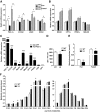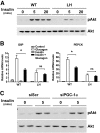Sensitivity of lipid metabolism and insulin signaling to genetic alterations in hepatic peroxisome proliferator-activated receptor-gamma coactivator-1alpha expression
- PMID: 19366863
- PMCID: PMC2699879
- DOI: 10.2337/db08-1571
Sensitivity of lipid metabolism and insulin signaling to genetic alterations in hepatic peroxisome proliferator-activated receptor-gamma coactivator-1alpha expression
Abstract
Objective: The peroxisome proliferator-activated receptor-gamma coactivator (PGC)-1 family of transcriptional coactivators controls hepatic function by modulating the expression of key metabolic enzymes. Hepatic gain of function and complete genetic ablation of PGC-1alpha show that this coactivator is important for activating the programs of gluconeogenesis, fatty acid oxidation, oxidative phosphorylation, and lipid secretion during times of nutrient deprivation. However, how moderate changes in PGC-1alpha activity affect metabolism and energy homeostasis has yet to be determined.
Research design and methods: To identify key metabolic pathways that may be physiologically relevant in the context of reduced hepatic PGC-1alpha levels, we used the Cre/Lox system to create mice heterozygous for PGC-1alpha specifically within the liver (LH mice).
Results: These mice showed fasting hepatic steatosis and diminished ketogenesis associated with decreased expression of genes involved in mitochondrial beta-oxidation. LH mice also exhibited high circulating levels of triglyceride that correlated with increased expression of genes involved in triglyceride-rich lipoprotein assembly. Concomitant with defects in lipid metabolism, hepatic insulin resistance was observed both in LH mice fed a high-fat diet as well as in primary hepatocytes.
Conclusions: These data highlight both the dose-dependent and long-term effects of reducing hepatic PGC-1alpha levels, underlining the importance of tightly regulated PGC-1alpha expression in the maintenance of lipid homeostasis and glucose metabolism.
Figures







Similar articles
-
Diminished hepatic gluconeogenesis via defects in tricarboxylic acid cycle flux in peroxisome proliferator-activated receptor gamma coactivator-1alpha (PGC-1alpha)-deficient mice.J Biol Chem. 2006 Jul 14;281(28):19000-8. doi: 10.1074/jbc.M600050200. Epub 2006 May 2. J Biol Chem. 2006. PMID: 16670093 Free PMC article.
-
Short-term inhibition of peroxisome proliferator-activated receptor-gamma coactivator-1alpha expression reverses diet-induced diabetes mellitus and hepatic steatosis in mice.Diabetologia. 2005 Sep;48(9):1860-71. doi: 10.1007/s00125-005-1866-4. Epub 2005 Jul 16. Diabetologia. 2005. PMID: 16025253
-
FGF21 induces PGC-1alpha and regulates carbohydrate and fatty acid metabolism during the adaptive starvation response.Proc Natl Acad Sci U S A. 2009 Jun 30;106(26):10853-8. doi: 10.1073/pnas.0904187106. Epub 2009 Jun 16. Proc Natl Acad Sci U S A. 2009. PMID: 19541642 Free PMC article.
-
PGC-1beta: a co-activator that sets the tone for both basal and stress-stimulated mitochondrial activity.Adv Exp Med Biol. 2009;646:133-9. doi: 10.1007/978-1-4020-9173-5_15. Adv Exp Med Biol. 2009. PMID: 19536672 Review.
-
The diverse role of the PPARγ coactivator 1 family of transcriptional coactivators in cancer.Semin Cell Dev Biol. 2012 Jun;23(4):381-8. doi: 10.1016/j.semcdb.2012.01.007. Epub 2012 Jan 21. Semin Cell Dev Biol. 2012. PMID: 22285815 Free PMC article. Review.
Cited by
-
The protein level of PGC-1α, a key metabolic regulator, is controlled by NADH-NQO1.Mol Cell Biol. 2013 Jul;33(13):2603-13. doi: 10.1128/MCB.01672-12. Epub 2013 May 6. Mol Cell Biol. 2013. PMID: 23648480 Free PMC article.
-
Impairment of PGC-1alpha expression, neuropathology and hepatic steatosis in a transgenic mouse model of Huntington's disease following chronic energy deprivation.Hum Mol Genet. 2010 Aug 15;19(16):3190-205. doi: 10.1093/hmg/ddq229. Epub 2010 Jun 7. Hum Mol Genet. 2010. PMID: 20529956 Free PMC article.
-
PPAR-gamma coactivator-1alpha regulates progesterone production in ovarian granulosa cells with SF-1 and LRH-1.Mol Endocrinol. 2010 Mar;24(3):485-96. doi: 10.1210/me.2009-0352. Epub 2010 Feb 4. Mol Endocrinol. 2010. PMID: 20133449 Free PMC article.
-
Physical exercise and liver "fitness": Role of mitochondrial function and epigenetics-related mechanisms in non-alcoholic fatty liver disease.Mol Metab. 2020 Feb;32:1-14. doi: 10.1016/j.molmet.2019.11.015. Epub 2019 Nov 29. Mol Metab. 2020. PMID: 32029220 Free PMC article. Review.
-
TM5441, a plasminogen activator inhibitor-1 inhibitor, protects against high fat diet-induced non-alcoholic fatty liver disease.Oncotarget. 2017 Sep 21;8(52):89746-89760. doi: 10.18632/oncotarget.21120. eCollection 2017 Oct 27. Oncotarget. 2017. PMID: 29163785 Free PMC article.
References
-
- Yeh MM, Brunt EM: Pathology of nonalcoholic fatty liver disease. Am J Clin Pathol 2007; 128: 837– 847 - PubMed
-
- Adiels M, Taskinen MR, Boren J: Fatty liver, insulin resistance, and dyslipidemia. Curr Diab Rep 2008; 8: 60– 64 - PubMed
-
- Lin J, Handschin C, Spiegelman BM: Metabolic control through the PGC-1 family of transcription coactivators. Cell Metab 2005; 1: 361– 370 - PubMed
Publication types
MeSH terms
Substances
Grants and funding
LinkOut - more resources
Full Text Sources
Molecular Biology Databases

